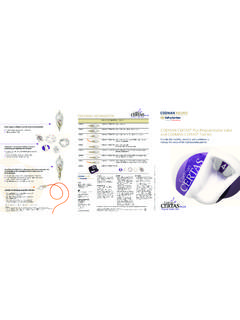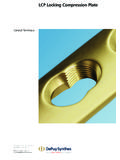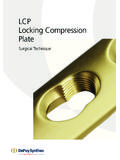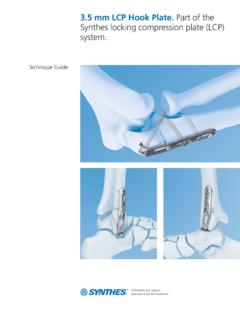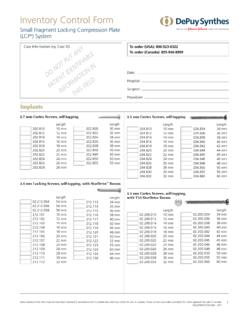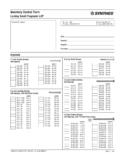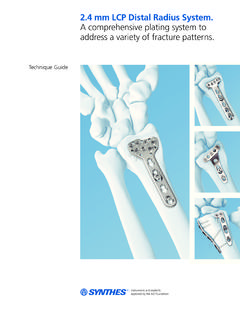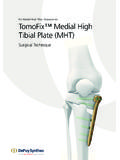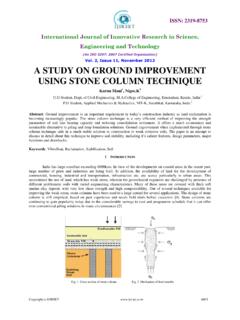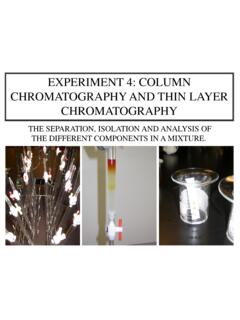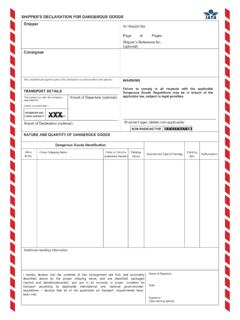Transcription of Variable Angle LCP Two-Column Volar Distal Radius Plate 2 ...
1 Variable Angle LCP Two-Column Volar Distal Radius Plate For fragment- specific fracture fixation with Variable Angle locking technology. Surgical Technique This publication is not intended for distribution in the USA. Instruments and implants approved by the AO Foundation. Image intensi er control Warning This description alone does not provide sufficient background for direct use of DePuy Synthes products. Instruction by a surgeon experienced in handling these products is highly recommended. Processing, Reprocessing, Care and Maintenance For general guidelines, function control and dismantling of m ulti-part instruments, as well as processing guidelines for i mplants, please contact your local sales representative or refer to: For general information about reprocessing, care and maintenance of Synthes reusable devices, instrument trays and cases, as well as processing of Synthes non-sterile implants, please consult the Important Information leaflet (SE_023827) or refer to: Table of Contents Introduction VA-LCP Two-Column Distal Radius Plate 2.
2 AO Principles 4. Indications 5. Clinical Cases 6. Surgical Technique Three Column Theory 7. Screw Insertion Techniques 8. Screw Angle Overview 10. Approach 12. Implantation 13. Postoperative Treatment/Implant Removal 28. Tips 29. Product Information Plates 30. Screws 31. Optional: Trial Implants 33. Instruments 34. Bibliography 38. MRI Information 40. Variable Angle LCP Two-Column Volar Distal Radius Plate Surgical Technique DePuy Synthes 1. Variable Angle LCP Two-Column Volar Distal Radius Plate For fragment- specific fracture fixation with Variable Angle locking technology. Features and Benefits The Variable Angle LCP Two-Column Volar Distal Radius Plate , featuring Variable Angle locking technology, is indi- cated for intra- and extra-articular fractures and osteotomies of the Distal Radius .
3 All implants are available in stainless steel and titanium. Dedicated screws For xation of radial styloid (blue) and support of lunate facet and DRUJ. (green). Bendable Two columns allow independent ne contouring of the radial and intermedi- ate columns Oblong combi-hole Allows accurate Plate positioning on the bone 2 DePuy Synthes Variable Angle LCP Two-Column Volar Distal Radius Plate Surgical Technique Anatomical fit Close to the Volar ridge with rounded Plate edges, polished surface and countersunk screws to reduce the risk of soft tissue irritation Variable Angle locking Holes allow up to 15 off-axis screw angulation in all directions in order to address the individual fracture patterns Kirschner wire holes Enable preliminary Plate xation Guiding block Allows guided drilling and screw inser- tion in the prede ned nominal Angle Variable Angle LCP Two-Column Volar Distal Radius Plate Surgical Technique DePuy Synthes 3.
4 AO Principles In 1958, the AO formulated four basic principles, which have become the guidelines for internal , 2 The principles as applied to the Variable Angle LCP Two-Column Volar Distal Radius Plates are: Anatomic reduction The use of Variable Angle locking technology allows frag- ment- specific fixation by providing the flexibility to lock screws in trajectories that can diverge from the central axis of the Plate hole. Variable screw angles provide fixation op- tions for a v ariety of fracture patterns. Stable fixation Variable Angle locking screws create a locked construct, providing angular stability. Preservation of blood supply Limited-contact Plate design reduces Plate -to-bone contact, limiting vascular trauma. Additionally, locked plates do not require close contact with the bone.
5 Early, active mobilization Early mobilization per standard AO technique creates an environment for bone healing, expediting a return to optimal function. 1. ller ME, Allg wer M, Schneider R, Willenegger H (1995) Manual of Internal M. Fixation. 3rd, expanded and completely revised ed. 1991. Berlin, Heidelberg, New York: Springer 2. R edi TP, Buckley RE, Moran CG (2007) AO Principles of Fracture Management. 2nd expanded ed. 2002. Stuttgart, New York: Thieme 4 DePuy Synthes Variable Angle LCP Two-Column Volar Distal Radius Plate Surgical Technique Indications Variable Angle LCP Two-Column Volar Distal Radius Plates are indicated for the fixation of intra- and extra-articular fractures and osteotomies of the Distal Radius . Variable Angle LCP Two-Column Volar Distal Radius Plate Surgical Technique DePuy Synthes 5.
6 Clinical Cases Case 1. 24-year-old male with AO fracture, fall from scaffold Preoperative, AP view Preoperative, lateral view Postoperative, AP view Postoperative, lateral view Case 2. 77-year-old female with AO 23C1 fracture, fall Preoperative, AP view Preoperative, lateral view Postoperative, AP view Postoperative, lateral view, 20 inclined 6 DePuy Synthes Variable Angle LCP Two-Column Volar Distal Radius Plate Surgical Technique Three Column Theory The treatment of Distal Radius fractures requires a meticulous reconstruction of the joint surface, as well as stable internal fixation and early functional post-operative treatment. Extra-articular fractures require both the restoration of the Volar tilt and radial length to reduce the possibility of dis- placement. Any malalignment may result in limitations of movement, changes of load distribution, mid-carpal instabil- ity as well as the increased risk of osteoarthritis in the radio- carpal joint.
7 Intra-articular fractures with articular displacement of more than 2 mm in the radiocarpal joint inevitably result in osteo- arthritis and functional impairment. The Distal Radius and Distal ulna form a three-column biome- chanical construction 3: The ulnar column is the Distal ulna, the triangular fibrocar- tilage and the Distal radio-ulnar joint. The intermediate column is the medial part of the Distal Radius , with the lunate fossa and the sigmoid notch. The radial column is the lateral Radius with the scaphoid VA-LCP Two-Column Volar Distal Radius Plate allows both fixation and fossa and the styloid process. buttressing of the two columns of the Distal Radius A dorsally displaced fracture of the Distal Radius indicates not only dorsiflection in the sagittal plane, but also radial devia- tion in the frontal plane and supination in the transverse Radial column plane.
8 Intermediate column Following reduction, stabilization requires optimal fixation of the intermediate column as well as the radial column. In the Ulnar column case of a fractured Distal ulna that compromises the Distal radio-ulna joint, the ulnar column must be stabilized as well. 3. ikli DA, Regazzoni P (1996) Fractures of the Distal end of the Radius treated by R. internal fixation and early function. A preliminary report of 20 cases. J Bone Joint Surg [Br] 78 (4):588 592. Variable Angle LCP Two-Column Volar Distal Radius Plate Surgical Technique DePuy Synthes 7. Screw Insertion Techniques Variable Angle locking screws can be inserted using two Funnel-shaped end for off- Fixed- Angle end for nominal different techniques: axis drilling Angle drilling Variable Angle technique Prede ned nominal Angle technique VA-LCP Drill Sleeve ( ).
9 VA-LCP Drill Sleeve, freehand ( ), for off-axis drilling Variable Angle technique 15 15 . To drill Variable Angle holes up to 15 deviation from the nominal trajectory of the locking hole, insert the tip of 1 2. the VA-LCP drill sleeve and key into the cloverleaf design of the VA locking hole (1). Use the funnel-shaped end of the VA-LCP drill sleeve to drill Variable Angle holes at the desired Angle (2). Alternatively, use the freehand VA-LCP drill sleeve and insert it fully into the VA locking hole (3). Use of funnel-shaped end of VA-LCP Drill Sleeve Drill Variable Angle holes at the desired Angle (4). 15 15 . Note: It is important not to angulate more than 15 from the central axis of the screw hole. Overangulation could 3 4. result in inappropriate screw locking. Moreover, the screw head may not be fully countersunk.
10 Use of freehand VA-LCP Drill Sleeve ( ). 8 DePuy Synthes Variable Angle LCP Two-Column Volar Distal Radius Plate Surgical Technique Predefined nominal Angle technique a) Use of fixed- Angle end of VA-LCP drill sleeve The fixed- Angle end of the VA-LCP drill sleeve only allows the drill bit to follow the nominal trajectory of the VA locking hole. Use of fixed- Angle end of VA-LCP drill sleeve b) Use of guiding blocks Fixation at the nominal Angle of the VA locking holes in the head of the Plate may also be facilitated by a guiding block attached to the Plate prior to Plate fixation. The guiding blocks are used together with the quick drill sleeve ( ). Choose the guiding block corresponding to the desired Plate (six or seven head hole configuration, left or right). Mount Use of guiding block with quick drill sleeve the guiding block to the Plate by turning the guiding block attachment screw clockwise.
